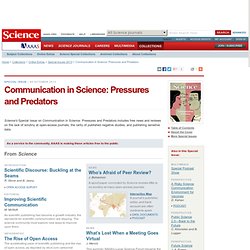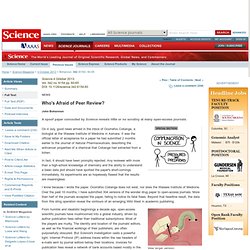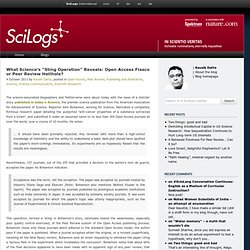

Special Issue: Communication in Science: Pressures and Predators. Science's Special Issue on Communication in Science: Pressures and Predators includes free news and reviews on the lack of scrutiny at open-access journals, the rarity of published negative studies, and publishing sensitive data.

As a service to the community, AAAS is making these articles free to the public. From Science Editorial Improving Scientific Communication M. As scientific publishing has become a growth industry, the standards for scientific communication are slipping. Infographic. Science: Who does peer review? Who's Afraid of Peer Review? A spoof paper concocted by Science reveals little or no scrutiny at many open-access journals.

On 4 July, good news arrived in the inbox of Ocorrafoo Cobange, a biologist at the Wassee Institute of Medicine in Asmara. It was the official letter of acceptance for a paper he had submitted 2 months earlier to the Journal of Natural Pharmaceuticals, describing the anticancer properties of a chemical that Cobange had extracted from a lichen.
In fact, it should have been promptly rejected. Any reviewer with more than a high-school knowledge of chemistry and the ability to understand a basic data plot should have spotted the paper's short-comings immediately. Its experiments are so hopelessly flawed that the results are meaningless. I know because I wrote the paper. From humble and idealistic beginnings a decade ago, open-access scientific journals have mushroomed into a global industry, driven by author publication fees rather than traditional subscriptions. Tangled web. What Science’s “Sting Operation” Reveals: Open Access Fiasco or Peer Review Hellhole? › In Sciento Veritas. The science-associated blogosphere and Twitterverse were abuzz today with the news of a Gotcha!

Story published in today's Science, the premier science publication from the American Association for Advancement of Science. Reporter John Bohannon, working for Science, fabricated a completely fictitious research paper detailing the purported "anti-cancer properties of a substance extracted from a lichen", and submitted it under an assumed name to no less than 304 Open Access journals all over the world, over a course of 10 months.
He notes: ... it should have been promptly rejected. Any reviewer with more than a high-school knowledge of chemistry and the ability to understand a basic data plot should have spotted the paper's short-comings immediately. Nevertheless, 157 journals, out of the 255 that provided a decision to the author's nom de guerre, accepted the paper. Acceptance was the norm, not the exception. And that is one of the major criticisms of this report. I agree. ... Prof. Martinenserink : More than half of 304 open... Ppandelis : @martinenserink the study does... Edyong209 : Science's fake paper sting... StewartVarner : uh, for the record, crappy... Flawed sting operation singles out open access journals. In a sting operation, John Bohannon, a correspondent of Science, claims to have exposed dodgy open access journals.

His argument seems to be that, because of their business model, some journals are biased towards accepting scientific articles, regardless of their quality. Sadly, Bohannon’s operation adds little to what we already know. Much new knowledge, often created by the use of taxpayers' money, is locked behind paywalls of subscription-based journals. But there is a growing movement to make this knowledge freely available. Researchers around the world are being urged to publish in open access journals, and many are seeking to do so. Where there is demand, the market learns to supply. What’s “open” got to do with it? The below is a piece that I wrote for The Conversation in the state before it was edited for publication there.

While the version published there captures better the sense of the sting article and the general background, I wanted to post my unadulterated version here as it shows my true thoughts for those already immersed in the debate. As you read this, Twitter is no doubt aflame with debate over the sting article on open access journals published in Science. The article details John Bohannon’s submission of over 300 bogus papers to open access journals listed in the DOAJ and on Beall’s list of “predatory open access publishers”.
Problematically, 157 of those journals accepted the obviously erroneous manuscript that featured ethical approval problems and clear scientific anomalies. On the surface this looks like a deadly blow to open access of the APC variety. Does Science do science? First and foremost, Bohannon’s methodology is dubious. I confess, I wrote the Arsenic DNA paper to expose flaws in peer-review at subscription based journals. In 2011, after having read several really bad papers in the journal Science, I decided to explore just how slipshod their peer-review process is. I knew that their business depends on publishing “sexy” papers. So I created a manuscript that claimed something extraordinary - that I’d discovered a species of bacteria that uses arsenic in its DNA instead of phosphorus.
But I made the science so egregiously bad that no competent peer reviewer would accept it. The approach was deeply flawed – there were poor or absent controls in every figure. RetractionWatch: Science reporter spoofs hundreds of open access journals with fake papers. Quite an improvement.